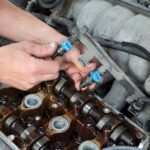Dealing with a “Catalyst System Efficiency Below Threshold Bank 1” error, often indicated by a P0420 code, can be frustrating. This issue signals that your car’s catalytic converter isn’t working as efficiently as it should, leading to potential emissions problems and decreased vehicle performance. My experience tackling this problem might offer some insights.
Initially, my Integra started burning oil, about 1.25 quarts every 1000 miles, and fuel economy dropped to 19 MPG. This oil consumption was fouling the catalytic converter, triggering the dreaded check engine light and the P0420 code. To temporarily address the clogged catalytic converter, I tried gutting it and installing an angled O2 sensor spacer on the downstream sensor. This trick silenced the check engine light and restored my MPG, but the car failed the emissions test. A used catalytic converter allowed me to pass emissions, but it eventually clogged up again due to the ongoing oil burning issue, bringing back the CEL and poor MPG.
Local repair shops quoted between $2,500 and $3,300 for a ring job and valve seal replacement to fix the oil burning, which seemed steep. Instead, I opted for a used JDM engine (B18B) from hmotorsonline.com for $900, including shipping. With an additional $500 for a local mechanic to swap over the necessary USDM parts, install the engine, and replace the timing belt, plus $600 for new parts, the total cost came to around $2,000.
Since the engine swap in 2012, the car has run smoothly for 25,000 miles, fuel economy is back up to 27 MPG, and it passes emissions without issues. While gutting the cat or using O2 sensor spacers might seem like quick fixes, they are not long-term solutions and can lead to emissions test failures. Addressing the root cause, in my case, engine oil burning, and considering a used engine replacement proved to be a more effective and economical solution for resolving the catalyst system efficiency problem.

